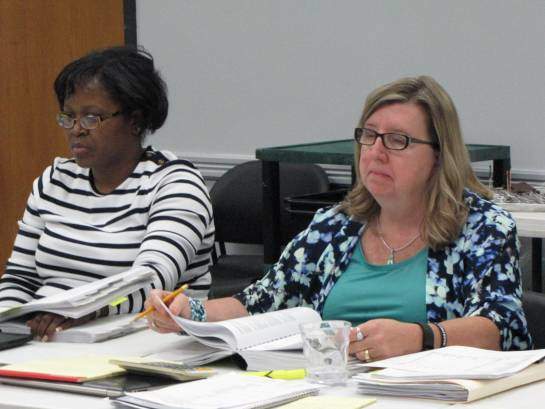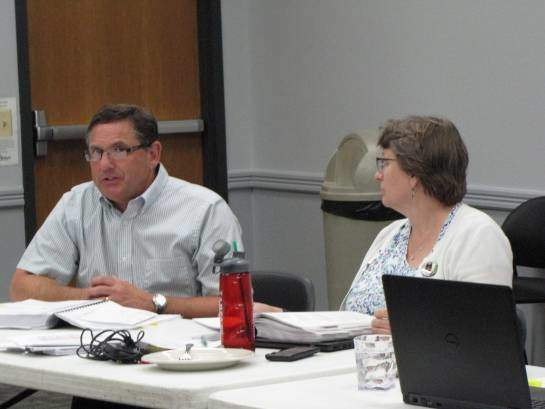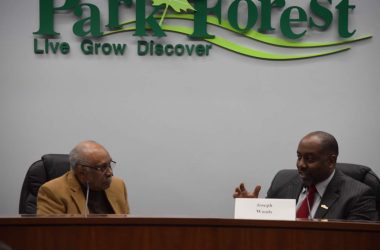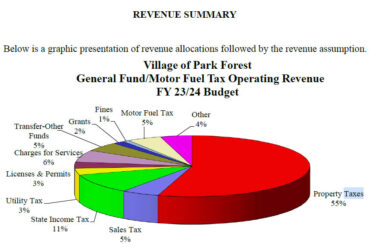
Analysis, Commentary, Report
By Gary Kopycinski
Park Forest, IL-(ENEWSPF)- The Village Board met in a budget session Monday night. On the docket, the Community Development Department. The meeting convened at 6 p.m. Currently, all board members are present. Trustee McCray was the last to arrive, showing up at 6:10 p.m.
Director of Building/Community Development Larrie Kerestes is taking the board through a rundown on vacant properties. He previously took the board through the numbers from the Housing Choice Voucher Program.
These numbers are incredible. Park Forest Housing Authority’s allocation is 177 vouchers. Currently, Park Forest has 159 vouchers. However, the village also has 484 portable vouchers, for a total of 661 vouchers. The Housing Authority of Park Forest must manage all of these vouchers, and considering that 484 vouchers represent 274% of its base allocation (figures from page 21-2 of the draft budget), this means that the Housing Authority of Park Forest is wildly underfunded by HUD.
According to the proposed budget, “data from February 2016 show that 288 or 60% of the portable vouchers are from the Housing Authority of the County of Cook 92 or 19% are from the Chicago Housing Authority and 104 or 21% are from various other housing agencies across the nation.”
There was some discussion of the number of vehicles behind an auto repair shop in the first block of South Orchard Drive. According to Larrie Kerestes, many of these vehicles are inoperable.
We wonder at eNews Park Forest, has this area turned into a junk yard?
Again, Mayor Ostenburg is driving the discussion with staff.
Some discussion on residents who might want to move to solar power as opposed to ground wires. Question from Trustee McCray, will the village put out information on solar v. ground wires. Larrie Kerestes says he gets perhaps one question per year from a resident on solar. Code Enforcement Manager Jerry Martin also said that, at this point, there are not a lot of solar vendors out there.
Director of Economic Development Hildy Kingma is now talking about houses demolished. With grants, she expects to see the village demolish about a dozen homes during the upcoming year. The plan, then, is to eventually rebuild on these areas where vacant or blighted homes have been demolished.
Again, Mayor Ostenburg is driving the discussion with staff.
No questions from the trustees on Capital Projects. On to Economic Development, chapter 9.

Chairman of the Economic Development Advisory Group, EDAG, Phil Perkins, is also in attendance to hear the budget presentation on Economic Development.
Back and forth between Mayor Ostenburg and Director Kingma. Ostenburg is raising an old point that is still true: a developer builds a development. The initial homeowner’s association agrees to certain responsibilities. Ten years or so down the road, future residents complain that they have responsibilities, while originally agreed to by the first homeowner’s association, do not seem fair to the future residents.
It’s an age old issue in Park Forest and beyond.
Mayor Ostenburg is telling the board that there seems to be a fresh interest among newer developers in what we have to offer in Park Forest, referencing a recent conversation he and Village Manager Tom Mick had with a developer regarding Blackhawk Plaza.
The village offers a bi-weekly Business e-Bulleting that goes out to over 1,000+ subscribers. “These bulletins also support Village sponsored events, highlight local events within the region, and feature area college events,” according to the budget (p. 9-6).
July MidSummer Madness has grown in popularity from 60 attendees in 2007 to 196 attendees in 2014 and 195 in 2015.
Some discussion of annexation of properties on both sides of Western Avenue south of Steger Road. These discussions have percolated in the past. Still a possibility.
Within two years, the Plan Commission wants to hold an envisioning session for the Eastgate Neighborhood toward planning a redevelopment of that area.
Some discussion on housing values in Park Forest. Mayor Ostenburg mentioned that housing values are lower than Chicago Heights, Richton Park, and such areas. Are these figures being influenced by the co-ops, which do not count as real estate, but are a completely different entity? Are short sales impacting these figures?
Take trulia.com, for example: http://www.trulia.com/real_estate/Park_Forest-Illinois/
The median selling price is shown to be $45,000, but that includes all of Park Forest, including cooperatives.
More participation in this discussion, still driven by Mayor Ostenburg, but Trustees McCray and Brandon are offering their insights as well.
There appears to be more truth to housing values being closer to the $45,000 mark as shown by the village’s own documents, specifically, the document prepared by staff for the Strategic Planning session in February of 2016.
That document reveals that the average price for a house in Park Forest declined drastically during the Great Recession, dropping from a high value in 2007 of $122,650 to $47,610 in 2015.
No questions from trustees for Director Kingma.
Now on to the DownTown with Sharon Bellino, Facility Manager.
All of the second floor businesses in the village-owned buildings now have new windows.
With the South Suburban Food Co-op moving out, village occupancy rate went from 80% to 78%.
The food co-op space is 3,000 square feet. Staff is targeting a Mexican restaurant, one in particular.
Years ago, the Lakota Group proposed a restaurant at that space with outdoor seating.
The village has seen a 13% return on the DownTown TIFF (page 18-4).
Mayor Ostenburg spoke about the lack of businesses in the South Suburbs, and the reason, he said, is because of our racial make-up. Can we embarrass people/businesses into doing the right thing? This is an issue we have been speaking about in Park Forest for years. We have a wealth of disposable income. What is the deciding factor that keeps businesses from locating in and around Park Forest?
Race.
The TIFF fund owes the village $4.8 million. By extending the TIFF, that money will come, returning on the investment, according to Mary Dankowski.
The meeting concluded after more discussion on general issues facing the village, sometime after 8 p.m.








